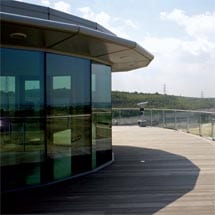
 Words by Michael Willoughby
Words by Michael Willoughby
Above the brownfields of the Thames Gateway development sits Campbell Architects’ Observatory, offering views of a town to be, discovers Michael Willoughby.
If you want to see the town of Ebbsfleet Valley, Kent, the best vantage point is the new Observatory building, high above it in nearby Swanscombe. But you will need to bring your imagination. The view, though spectacular, consists of about 242 hectares of wet, cracked sandy mud surrounded by small cliffs and dotted with lakes.
The conurbation-in-waiting (blame the God-like altitude for such a word), is part of government plans for the Thames Gateway and one of the more concrete signs that at least one aspect of the vastly hyped initiative is actually happening. Land Securities, Europe’s largest property firm, is taking great care with planning the new town’s development. It appears that getting people to move to what is a fairly desolate part of England will not necessitate a Chairman Mao-style workforce redeployment.
But it will certainly need time to turn this quintessential brownfield site into habitable space. Up until a few years ago, the site was a vast cement quarry owned by Blue Circle and it will be more than 20 years before a new town with the population of Chichester will be going about its business in an area the size of three Hyde Parks. From this point, the view will be of a new settlement consisting of 10,000 houses, occupied by people working 20,000 jobs in 600,000sq m of offices and half that again of retail, leisure and community space.
The Observatory, then, designed by London-based Campbell Architects, does two things: it helps people visualise this unimaginable new place and it provides a space in which to engage various interested publics. The three-storey building – “a straight side, a curved side andtwo pointy ends,” according to architect Chris Campbell – was built on the point at which Land Securities’ design director Adam Cunnington often took visitors when they toured the site. Shaped to maximise the views, it has a curved glass front that runs around 180º to show work underway.
The ground floor of the Observatory comprises a vestibule, reception, office space and meeting rooms. The reception has a custom-made sofa curved to fit the sweep of the building. Beyond that, with a visual link to the front, is the office space that is home to a few permanent staff and a number of team members in the area when needed. All office furniture was “borrowed” from head office – the chairs for the meeting rooms were supplied by Vitra.
On the first floor, in addition to more meeting rooms, there is an exhibition space with several displays covering the history of the site, its sustainability credentials, the local wildlife, etc. Next to these are a scale model and artifacts from previous civilisations, such as pottery, encased in perspex. It feels like the most local of local museums. The site, however, is of genuine archaeological interest. The country’s second oldest human remains, Swanscombe Man (actually a woman) dating from 40,000 years ago, were found nearby.
The top floor is open to the sky with timber decking, telescopes and a mock-heroic commentary provided by Tom Baker in Little Britain mode. The most interesting sight at the moment is the 380kV Thames Crossing pylon. Baker’s sarcastic but affectionate tone – “the Church of St Peter and St Paul, a bastion of solidity in a world of change!” – is either screamingly funny or a slightly arrogant piss-take by the invader outsiders. It’s hard to decide which.
The Observatory is an exhibition space for all that has happened and all that will happen, while the view from the roof shows what is happening now. Recently, one could have observed the removal of a stubborn neighbouring hill.
However, Land Securities is at vast pains to show that Ebbsfleet Valley isn’t going to be a typical development with rows of identical houses, cul-de-sacs and shopping arcades.
It wants to demonstrate that it cares, that it has taken time and put resources into the design. And that much is clear.
In planning the town, the company engaged in a complex exercise in sustainability, local consultation, careful transport planning, habitat sensitivity and design-oriented building. The residents will be able to frolic in 400 acres of parkland, and enjoy the lakes and the pint-size cliffs, which were left from the land’s earlier exploitation. In fact, a 150-page biodiversity report has been prepared to the delight (so Cunnington tells me) of Kent Wildlife Trust and Natural England. Property behemoth Land Securities is behaving exactly opposite to its Monopoly stereotype.
So why this attention to detail? Why all this niceness? “We are building value in every way; pushing up the liveability and the desirability,” Cunnington tells me. Perhaps Land Securities simply wants to maximise its asset. Transportation is key to its initial investment. Ebbsfleet International, two hours and five minutes from Paris, will be opened in November. The station will link to the new London Eurostar terminal in St Pancras – journey time 17 minutes – when it is completed next year. The town is connected to nearby Dartford, Bluewater (Europe’s largest shopping centre) and Gravesend by the innovative Fastrack, a rethink of a local bus service with reliable arrival times, designated lanes and vehicle priority.
The Observatory is visited by all sorts of people, locals included, from the keen to the curious to the conservative. “People say, ‘You are going to Thames Gateway? Oh, you’ve got to see the Observatory! You can’t miss that!’” Cunnington says. Indeed, as I leave, a group from Kent University are waiting to see him. Last week alone, 200 people came through the building to gaze down on the mudflats, including three busloads from Eurostar, officials from the Central England Development Agency and assorted Russians.
For meetings (or “a cup of tea and a chit chat” as Cunnington puts it) there is an 18-person boardroom on the first floor and two ten-person meeting rooms on each floor. The boardroom is incredibly popular, he tells me. “The real challenge is preserving its special-ness,” he says. With all the coming and goings, in fact, the Observatory might just be the most useful pavilion in the world.
At present, the building is chiefly at the vanguard of a public relations exercise. Three permanent members
of staff work here during the week and the London-based team frequently visit. There is a slot between the office and the reception desk that ensures that no one goes ungreeted should the security guard be somewhere else.
This was an expensive build, mainly due to the price of adapting the location for its purposes. “The road is longer than would normally be expected for access to a building,” says Campbell, “but this was due to the fact that we wanted to get to the highest point of the site and the location was up a remote track.” The distinctive hairpin approach had to be designed to accommodate wheelchairs. The Observatory is all about access.
But, decided Cunnington, if visitors were going to get a sense of the development-to-be, expensive choices had to be made. “There was no other natural viewpoint,” he says. “There was a farmhouse down the bottom, but it was at the wrong end. There was another place but it was in a complete dip. The view from other areas was slightly meaningless.”
Bringing people up to the point along a tangled pathway sometimes resulted in grumbling visitors. “People would complain,” he says. “They would say things like: ‘Are we nearly there yet?’ But then they would emerge and they would say: ‘Wow!’ And that reaction meant that, no matter what it cost, this was the right place to put the building because people wouldn’t go away with bad impressions.”
There were some cost restrictions, though. The interrupted view from the office is one of a couple of areas where a tight budget erased design features. A spiral staircase, which would mark out the centre core, was planned but came in at too much. “We argued our case,” says project architect Andy Korn, “but in the end it was too expensive.”
Was there anything that the architects would have improved had they been given carte blanche? “Maybe curved glass,” says Campbell, idealistically. Despite the budget limitations, the office also ended up with a small landscaped garden, which overlooks the soon-to-be unfolding scene as well as a bike rack with no bikers. “People come out here to munch on their sandwiches,” says Cunnington. “And we had a great team barbecue here.”
And Campbell was also keen on making sure the front of the building provided some interest. The ground floor is set back to give it a little more depth. “If it had been on a single plane, it would have been a bit bland,” Campbell says. “But the layering and definition give it some light and shadow.”
In time, the use of the Observatory will change. At present, it is home to various wandering project managers and construction people. There is a consortium of architects bidding for Kent’s Schools for the Future programme in residence as I visit. People come down from London to get some work done, Cunnington tells me. “The phones ring less often,” he says. “The Observatory is all we could have asked for and more.”
There is an element of cosiness about today’s operation. Despite being a high-flying property executive in Europe’s largest property company, Cunnington uses words and phrases like “chit chat”, “munching” and “wow!” His mum is booking out the exhibition hall for her Rotary Club in May. But his casual manner doesn’t grate like some over-familiar vicar or teacher. Is he the real thing – a familial, sensitive property developer?
“We’re a small team,” he laughs. But groundbreaking at the first site is due to take place later this month and soon the building will be home to a different group of people.
The brownfields and the Observatory will gradually fill up with those designing schools and transport and services, offices, shops and homes. Land Securities will turn its activities to what it knows best (community relations aside): building and building big.


























